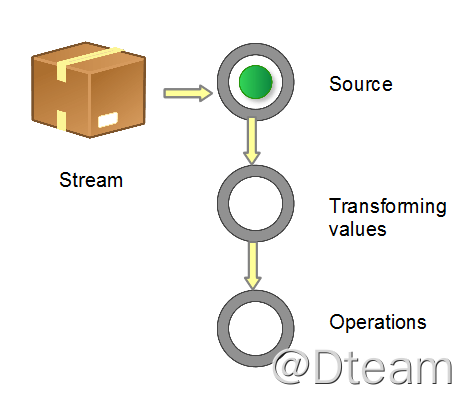DTeam 技术日志
Doer、Delivery、Dream
利用Java的Stream API处理海量数据
前言
最近优化一个旧的 HBase 查询程序,在 HBase 查询出来的数据量太大的时候就会出现性能下降、内存溢出的问题。遂着手优化这个问题,将解决过程记录下来。
问题描述
一个旧的 HBase 查询程序,会从 HBase 数据库查询所需要的记录,将查询结果以 JSON 形式返回给客户端,整个程序基于 Vertx 之上构建。但是我们都知道 HBase 存储着海量的数据,当数据量太大的时候,这个程序就会出现响应速度慢,甚至内存溢出等现象。最近准备迁移旧的系统,于是着手修复这个问题。
问题分析
首先很容易想到的就是查询数据 –> 响应给客户端这部分可能出了问题,先看看这部分程序的代码(groovy)。大致如下(代码示例而已,非完整可执行代码):
List<JsonObject> scanResult() {
Scan scan = new Scan() // 其他查询条件忽略
ResultScanner resultScanner = hTable.getScanner(scan)
LinkedList list = new LinkedList()
resultScanner.each { Result result ->
List data = []
result.rawCells().each {
data << new JsonObject(Bytes.toString(CellUtil.cloneValue(it))
}
list.addFirst(data)
}
resultScanner.close()
list
}
Closure responseToClinet(RoutingContext context) {
{ List result ->
JsonObject data = new JsonObject()
data.put('success', true)
data.put('result', result)
context.response().end(data.encodePrettily(), 'utf-8')
}
}
将从 HBase 中查询的结果放入一个List<JsonObject>中,再将这个 json 格式化之后响应给客户端。所以这个问题就很明显了,如果这个Scan的结果集特别大,将会造成整个 List 内存溢出,而且将 List 格式化成 Json 也需要消耗大量的时间,这就造成客户端请求的时候往往等上半天。
第一次优化
首先解决一下 Json 格式化的消耗问题,将一个超大的 Map 在内存中格式化成 Json 输出给客户端,这个操作本身就需要消耗大量的时间和内存,所以先从这里入手,规避在最后把一个超大的 JsonObject 对象格式化,而是在输出之前我就手工格式化成 json 字符串流的形式,不需要在输出的时候做。正好 vertx 在HttpServerResponse是支持io.vertx.core.buffer.Buffer的,那么我在格式化List<JsonObject>这里的时候就手工拼接成一个String.join(",")的形式就好了
Buffer scanResult() {
Scan scan = new Scan() // 其他查询条件忽略
ResultScanner resultScanner = hTable.getScanner(scan)
Buffer buffer = Buffer.buffer()
resultScanner.each { Result result ->
result.rawCells().each {
String cellValue = Bytes.toString(CellUtil.cloneValue(it))
if (buffer.length() > 0) {
buffer.appendString(',' + cellValue)
} else {
buffer.appendString(cellValue)
}
}
}
resultScanner.close()
buffer
}
Closure responseToClinet(RoutingContext context) {
{ Buffer result ->
// 期望响应格式{"success":true,"result":[e1,e2,...,en]}
HttpServerResponse response = context.response()
response.setChunked(true)
response.putHeader('Content-Type', 'application/json')
response.write('{"success":true,"result":[')
if (result) {
response.write(result)
}
response.end(']}')
}
}
很好,我们用手工拼接 Buffer 的形式,拼接出了一个超大的 json 字符串,这样节省了大量格式化 json 的时间。目前我们将一个原有 5 秒才能出结果的查询,降低到了 0.5 秒出结果,已经将速度大幅提升了。
但是这还不够,我们放开查询条件,进一步扩大 Scan 的结果集,依旧会出现内存溢出的错误。进一步审计代码和堆栈,发现这里出了问题:
Buffer buffer = Buffer.buffer()
resultScanner.each { Result result ->
result.rawCells().each {
String cellValue = Bytes.toString(CellUtil.cloneValue(it))
if (buffer.length() > 0) {
buffer.appendString(',' + cellValue)
} else {
buffer.appendString(cellValue)
}
}
}
我们在循环中不断追加 buffer,但是结果集超大,超出我们的预期的时候,buffer 还是会把内存撑爆。看来我们还是得找更好的方案。
第二次优化
进一步审计ResultScanner的代码,发现它是这么定义的:
/**
* Interface for client-side scanning.
* Go to {@link Table} to obtain instances.
*/
@InterfaceAudience.Public
@InterfaceStability.Stable
public interface ResultScanner extends Closeable, Iterable<Result>
ResultScanner是一个Iterable对象。那我们可以这么考虑,能不能不要在迭代中一直拼接 Buffer,而是迭代中每格式化一个 Buffer 之后,就把 Buffer 写入响应流中呢?这样不就解决了拼接 buffer 造成内存溢出的问题了吗?而且可以让响应时间进一步缩短。
这里就是 Java 8 新引入的java.util.Stream API 了,不同于 nio 的Stream,这里的 Stream 是为了实现流式处理的接口,而且可以和 java 8 新加入的 Lambda 表达式进行更加灵活的处理。Stream 就像水流一样,处理完就丢掉了,不会向前遍历,可以很方便的构造数据处理管道,正好符合我们的这个场景。一个 Stream 的典型处理场景如下:

而Iterable对象是非常容易转成Stream的,在 java 8 就提供了一个工具类java.util.stream.StreamSupport,可以很方便的把Iterable对象转成Stream。于是我们的代码改造如下:
Itertor<Buffer> scanResult() {
Scan scan = new Scan() // 其他查询条件忽略
resultScanner = hTable.getScanner(scan)
boolean first = true
StreamSupport.stream(resultScanner.spliterator(), false).map({ Result result ->
Buffer buffer = Buffer.buffer()
result.rawCells().each {
String cellValue = Bytes.toString(CellUtil.cloneValue(it))
if (first) {
buffer.appendString(cellValue)
} else {
buffer.appendString(',' + cellValue)
}
first = false
}
buffer
}).iterator()
}
Closure responseToClinet(RoutingContext context) {
{ Iterator<Buffer> bufferIterator ->
// 期望响应格式{"success":true,"result":[e1,e2,...,en]}
HttpServerResponse response = context.response()
response.setChunked(true)
response.putHeader('Content-Type', 'application/json')
response.write('{"success":true,"result":[')
bufferIterator?.each {
response.write(it)
}
response.end(']}')
}
}
// 调用部分示例,需要在迭代完成close掉ResultScanner
{ Iterator<Buffer> bufferIterator ->
resultScanner?.withCloseable {
responseToClinet(context).call(bufferIterator)
}
}
至此,所有问题都得到了解决,查询再大的数据量也不会造成内存溢出了。
小结
本章我们通过一个实际的项目案例分析,展示了大数据处理的思想,以及使用 Java 8 新增的 Stream API 解决我们实际的问题。
觉得有帮助的话,不妨考虑购买付费文章来支持我们 🙂 :
付费文章